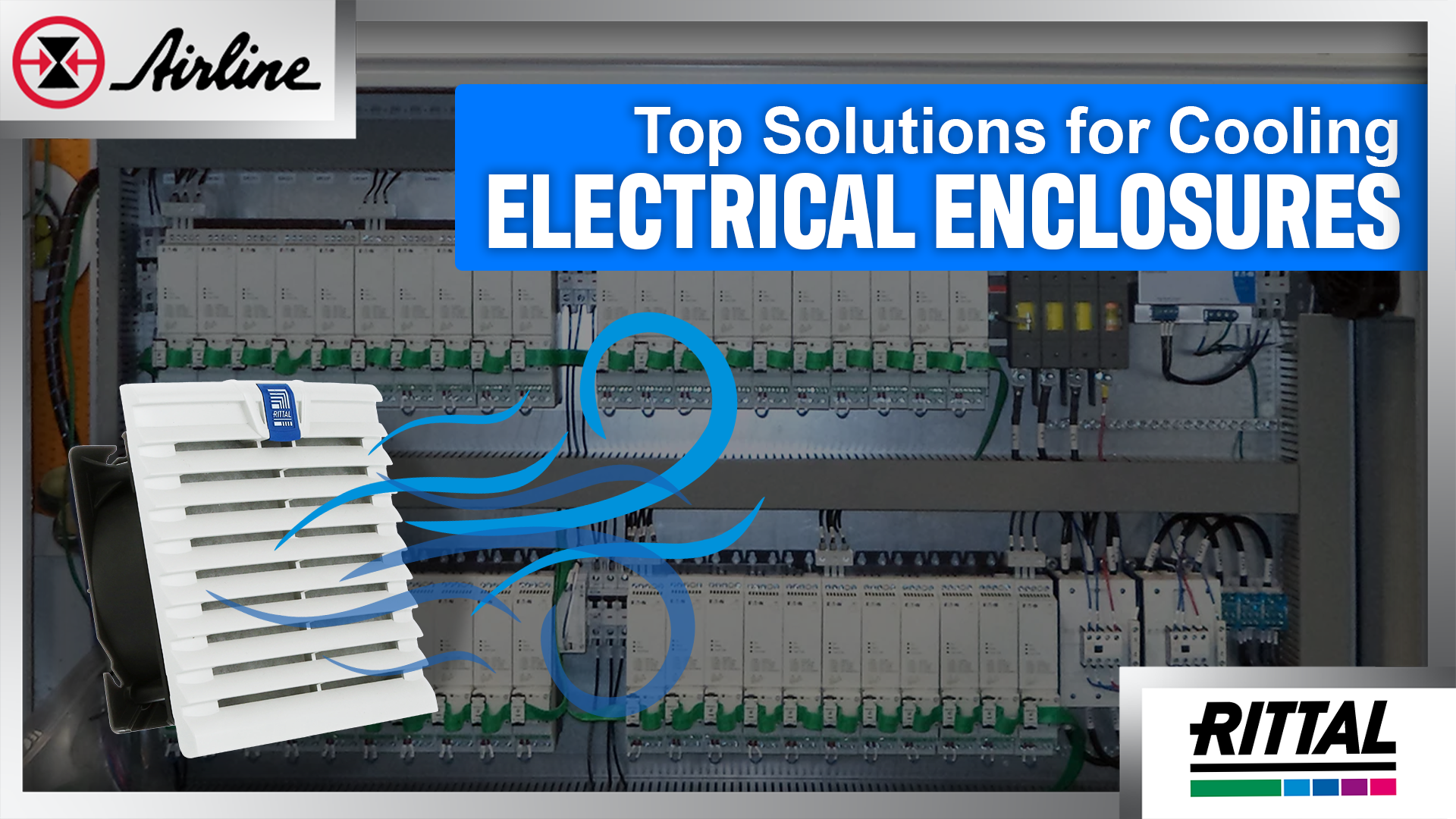Editor’s Note: This blog post has been updated in July 2024 (originally published in July 2021) for accuracy and comprehensiveness.
It’s summertime, and like it or not, the weather is HOT! We're lucky enough to beat the heat with air-conditioning... but what about our electrical components? Not only are they sensitive to heat and humidity, but they generate heat as they run, all within the confines of an enclosed space. Excessive heat needs to be dissipated to prevent excessive temperatures. But when is it too hot, and what's the best way to cool it down?
In this blog post, learn why climate control is important, how to know when your enclosure is too hot, and different methods of dissipating the heat.
Skip to a Section
Electrical Enclosure Climate Control | Too Hot | Calculating Enclosure Cooling Requirements | Active Cooling Methods | Passive Heat Dissipation Techniques | Vortex Tube Technology | Thermostatically Controlled Cooling Solutions | Frequently Asked Questions | Additional Resources
Key Takeaways✔️ Proper climate control within electrical enclosures is essential to prevent overheating, extend the lifespan of components, and reduce maintenance costs.
|
Importance of Electrical Enclosure Climate Control
For electronic components, the performance, lifespan, and safety heavily rely on proper climate control within electrical enclosures. Failing to control the temperature adequately can result in severe performance issues and even failures due to the heat produced by semiconductor devices like diode rectifiers and transistor inverters. It’s a known fact that every 10°C rise over the rated temperature limit can halve the life expectancy of electrical components. This makes managing the heat inside the enclosure not just important but essential for the longevity of your equipment.
Overheating and condensation inside electrical enclosures can cause significant failures, increasing maintenance costs and potential safety hazards. The cost of implementing a robust climate control system upfront is typically lower than the cost of replacing damaged equipment. Minimizing the risks of temperature damage and corrosion, proper climate control extends the lifespan of your electronic control panels and reduces the risk of expensive downtime.
Determining When an Electrical Enclosure is Too Hot
To prevent damage and ensure the lifespan of electrical components, it’s vital to identify when an electrical enclosure is overheating. Some signs of overheating include:
- Charred or blackened components inside the enclosure
- Burn marks on the board substrate
- Delamination resulting in bubbles or blister-like spaces
- A burning smell emanating from the enclosure
These signs indicate when the temperature and relative humidity inside the enclosure have exceeded safe limits.
Many electrical devices housed in enclosures are rated for operation within a specific temperature range, up to 60°C (140°F). Variable frequency drives (VFDs), for instance, commonly have an operational rating of up to 40°C (104°F), making it essential to monitor the temperature closely. Recognizing these warning signs early enables you to take necessary steps, implement effective enclosure cooling solutions, and prevent irreversible damage.
Calculating Enclosure Cooling Requirements
Efficient temperature control depends on the fundamental step of calculating your enclosure cooling requirements. To accurately determine your enclosure cooling requirements, the best course of action is to contact a professional to audit the climate of your facility and enclosures. This allows a professional to walk through your application and measure all applicable data points to calculate your cooling requirements. Professional climate audits ensure cooling requirements are accurate for all temperatures and elements to which electrical components are exposed.
Active Cooling Methods for Electrical Enclosures
Keeping electrical enclosures cool requires active cooling methods. These methods include:
- Fans and blowers
- Air-to-air heat exchangers
- Enclosure air conditioners
- Air-to-water heat exchangers
Each of these systems plays a pivotal role in dissipating heat and ensuring the longevity and performance of electronic components.
Let’s explore each method in detail.
Fans and Blowers
Fans and blowers are among the most common and straightforward methods of enclosure cooling. They operate by drawing cooler ambient air into the enclosure while expelling hot air, thereby preventing thermal buildup. Axial fans, which provide airflow parallel to the fan’s shaft, are commonly used for general-purpose cooling, while centrifugal fans generate airflow perpendicular to the fan’s shaft, making them effective for applications requiring higher static pressure.
Blowers, on the other hand, produce a wide, laminar airflow and are suitable for compact electronic devices where space is limited. Fans and blowers circulate ambient air through electrical enclosures, aiding in heat dissipation from internal components and keeping the internal temperature within safe limits.
Air-to-Air Heat Exchangers
Air-to-air heat exchangers are another effective method for cooling electrical enclosures. These systems transfer heat from inside the enclosure to the outside environment using a closed-loop system that keeps internal and external air separate. This separation ensures efficient heat transfer while preventing contaminants from entering the enclosure.
The closed-loop nature of air-to-air heat exchangers makes them particularly suitable for environments where maintaining a controlled internal air temperature is crucial. These systems manage the temperature inside the enclosure efficiently, safeguarding sensitive electronic components from overheating and prolonging their operational lifespan.
 Shop Air-to-Air Heat Exchangers
Shop Air-to-Air Heat Exchangers
Enclosure Air Conditioners
Enclosure air conditioners are designed to maintain a stable internal temperature using refrigerants to cool the air inside electrical enclosures. These systems operate using a closed-loop system that ensures contaminants do not enter the enclosure, thereby maintaining a controlled environment. This is crucial for the performance and longevity of electrical components, as stable temperatures prevent the risk of overheating and subsequent failures.
The use of refrigerants allows enclosure air conditioners to achieve lower temperatures than other cooling methods, rendering them perfect for environments requiring precise temperature control. Their ability to maintain a consistent internal temperature ensures that electronic control panels and other components operate efficiently and safely.
 Shop Enclosure Air Conditioners
Shop Enclosure Air Conditioners
Air-to-Water Heat Exchangers
Air-to-water heat exchangers provide an efficient cooling solution by transferring heat to a water source, which then dissipates the heat away from the enclosure. These systems are particularly effective in industrial settings where machines or processes are already cooled by tempered water. The use of water as a cooling medium allows for effective heat removal even in environments with high ambient temperatures or oily atmospheres.
Air-to-water heat exchangers, which can include heat pipes, exploit the existing water cooling infrastructure to control the temperature effectively inside electrical enclosures, thus ensuring the protection and reliability of the contained components.
 Shop Air-to-Water Heat Exchangers
Shop Air-to-Water Heat Exchangers
Other active cooling methods include chillers and thermoelectric coolers, to name a few. If you’re considering applying an active cooling method to your cabinet, do some research, or contact climate control professionals, like Airline to find the best method for your environment and application.
Passive Heat Dissipation Techniques
Passive heat dissipation techniques rely on natural airflow and thermal conductivity to manage temperatures within electrical enclosures. These methods do not require additional energy-consuming components and can create uniform heat loss throughout the enclosure.
Let’s explore some of the most effective passive heat dissipation techniques.
Increasing Enclosure Surface Area
Increasing an enclosure's surface area can significantly enhance its ability to dissipate heat through natural convection. By adding fins or heat sinks to the surface, the enclosure exposes more area to the air, allowing for better heat dissipation. Free-standing enclosures are often used to maximize the surface area available for passive cooling.
This method can be particularly effective in reducing the enclosure's maximum internal temperature. Optimizing the surface area ensures the effective dissipation of the heat generated by the internal components into the surrounding environment.
Tweaking Cabinet Design
![]() Tweaking the cabinet's design can also improve passive heat dissipation. Adding ventilation grills or using a slightly larger enclosure can significantly reduce internal temperatures by facilitating natural airflow. Design features like strategically placed vents and louvers can enhance the natural airflow through the enclosure, aiding in passive cooling and maintaining a slight positive pressure.
Tweaking the cabinet's design can also improve passive heat dissipation. Adding ventilation grills or using a slightly larger enclosure can significantly reduce internal temperatures by facilitating natural airflow. Design features like strategically placed vents and louvers can enhance the natural airflow through the enclosure, aiding in passive cooling and maintaining a slight positive pressure.
Repositioning components with the highest heat loss outside the enclosure is another effective strategy. Improving the cabinet’s design and layout enhances its heat dissipation ability without the reliance on active cooling methods.
Considering Material and Ambient Temperature
The material of the enclosure plays a significant role in its passive cooling efficiency. Materials with high thermal conductivity, such as aluminum, are often chosen for enclosures to facilitate better heat dissipation. Stainless steel, with its specific heat transfer coefficients, also impacts the enclosure’s cooling capacity.
Evaluating ambient temperature conditions is crucial, as high surrounding temperatures can exacerbate internal heat generation within the enclosure. Cooler ambient air temperatures around the enclosure aid in more effective passive heat dissipation. Considering both the material and the ambient conditions optimizes the enclosure’s passive cooling performance.
Learn how to properly size climate control devices with Rittal's FREE software, THERM.
Vortex Tube Technology for Enclosure Cooling

Vortex tube technology offers an innovative solution for enclosure cooling. It uses a compressed air supply to separate cold and hot air streams while managing air consumption efficiently. First invented by French physicist Georges Ranque in 1930 and later developed for industrial use by Vortec in the 1960s, vortex tubes are a maintenance-free and highly reliable cooling option. These tubes are compact, ranging from 6 to 13 inches long, and can produce cold air with cooling capacities ranging from 100 to 6000 BTU/hour.
Standard Vortex Enclosure Coolers are available in NEMA 12, NEMA 4, and NEMA 4X versions. They maintain a slight pressurization in the cabinet to keep electrical and electronic components clean and dry. Vortex tubes, which generate cold air from compressed air without any moving parts, offer efficient and reliable cooling for electrical enclosures.
Thermostatically Controlled Cooling Solutions
Thermostatically controlled cooling solutions are designed to:
✔️ Maintain consistent temperatures within electrical enclosures
✔️ Ensure optimal operating conditions for internal components
✔️ Provide improved performance reliability by preventing exposure to temperatures above the maximum rating of the electronics
✔️ Extend the lifespan of the electronics
Thermostatically controlled solutions enhance safety by maintaining controlled temperatures, thus reducing the risk of electrical hazards such as fires or explosions. These systems are an ideal solution for environments where precise temperature control is crucial for the performance and longevity of electronic control panels and other components.
Proper climate control in electrical enclosures is essential for the performance, longevity, and safety of electronic components. By understanding when an enclosure is too hot and calculating the cooling requirements, you can implement effective cooling solutions. Ensuring proper cooling for your electrical enclosures is not just about maintaining optimal performance—it’s about safeguarding your entire operation. Contact us today to have a professional audit the climate of your facility and enclosures.
If you have a question or comment about this post, please leave it in the comments below!
Additional Resources
- How to Correctly Size Electrical Climate Control Products
- Rittal Climate Control Overview
- Rittal Maintenance/Service Page
Contact Us
Ask our Rittal product experts for help with climate control.
800-999-7378











Leave Comment